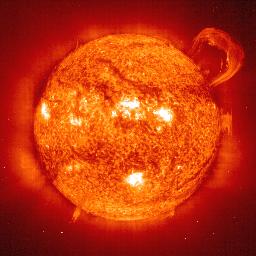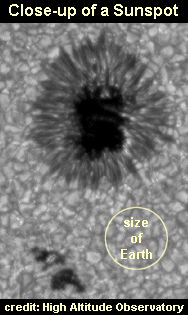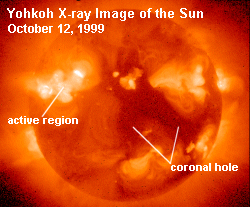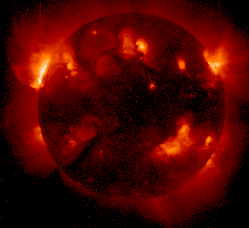Sunspot Facts
Table of Contents
The sun is commonly regarded as a featureless, unchanging ball of light. The Sun, on the other hand, has seasons, or cycles of activity and relative inactivity. We are now approaching the peak of the current solar cycle’s activity.
 The Sun produces numerous sunspots, flares, and coronal mass ejections on a daily basis. Radio communications, power distribution, orbiting spacecraft, and even the weather are all affected by an active Sun here on Earth.
The Sun produces numerous sunspots, flares, and coronal mass ejections on a daily basis. Radio communications, power distribution, orbiting spacecraft, and even the weather are all affected by an active Sun here on Earth.
Sunspots
Sunspots are dark blotches on the Sun that are relatively cool. Scientists count the number of sunspots to determine the magnitude of a solar cycle and how long it lasts. If scientists could predict sunspot activity, we would not only know what the Sun would do ahead of time, but we might also gain a better understanding of how the Sun works.
Nearly 400 years ago Galileo looked at the bright Sun through a telescope. Needless to say, this ill-advised activity caused him to see spots and suffer from partial blindness. However, some of those spots were real. Galileo, along with other scientists of his time, had discovered sunspots!
 Sunspots are dark areas on the sun’s fiery surface. They are cooler than their surroundings, but that doesn’t mean they are cold. A thermometer inserted into a sunspot would register a sizzling 3000 – 4000 K. Compared to the size of the Sun, sunspots appear tiny, but many are larger than the Earth.
Sunspots are dark areas on the sun’s fiery surface. They are cooler than their surroundings, but that doesn’t mean they are cold. A thermometer inserted into a sunspot would register a sizzling 3000 – 4000 K. Compared to the size of the Sun, sunspots appear tiny, but many are larger than the Earth.
Heinrich Schwabe, an amateur astronomer, discovered in 1843 that sunspots come and go in an 11-year cycle. At the peak of the sunspot cycle there is lots of solar activity, including frequent solar flares and coronal mass ejections. Here on Earth we feel the effects of the solar maximum when geomagnetic storms cause power outages and interfere with satellites and radio communications. Some people claim that even the stock market and the length of mini-skirts are affected!
Four Facts about Sunspots
The number of sunspots on the face of the Sun varies with an 11 year period called the sunspot cycle. The next sunspot maximum (also known as the “solar maximum”) is expected to take place between November 2024 and March 2026, but most likely around July 2025.
Sunspots have strong magnetic fields, thousands of times stronger than Earth’s. The magnetic fields help keep sunspots cool and also serve as a reservoir of energy for explosive events like solar flares.
Sunspots were discovered by Galileo Galilei and Thomas Harriot around the end of 1610. Johannes Kepler may have been the first to see a sunspot in 1607, but he thought the dark spot was Mercury crossing the disk of the Sun.
Sunspots appear dark because they are cooler than the surface of the sun. In fact they are very hot and bright. If you were to put a sunspot in the night sky, it would glow brighter than the Full Moon with a crimson-orange color!
Sunspot Maximum
The maximum number of sunspots is usually a broad peak. There is a two- to three-year period when activity is extremely high.
Extra ultraviolet (UV) and X-ray radiation produced by magnetic fields around sunspots heats and expands the Earth’s atmosphere. This adds drag to the region where low-Earth orbit satellites and the Space Shuttle orbit. Solar flares and energetic particle events exacerbate the situation by disrupting satellite and shortwave radio communications.
 The Japanese Yohkoh X-ray Observatory captured this x-ray image of the sun on October 12, 1999, showing the coronal hole that has rotated into a favorable position to send high-speed solar wind particles toward Earth. Over the next few days, the resulting gust of solar wind is expected to buffet Earth’s magnetic field and cause moderate geomagnetic disturbances.
The Japanese Yohkoh X-ray Observatory captured this x-ray image of the sun on October 12, 1999, showing the coronal hole that has rotated into a favorable position to send high-speed solar wind particles toward Earth. Over the next few days, the resulting gust of solar wind is expected to buffet Earth’s magnetic field and cause moderate geomagnetic disturbances.
“The magnetic fields around coronal holes are different,” he continued. “Instead of looping back to reconnect on the sun’s surface, these magnetic fields are essentially open. They go way out into the solar system and no one knows exactly where they reconnect. These open field lines allow high-speed solar wind particles to escape.”
In fact, solar wind emanates from the Sun in all directions, not just coronal holes. However, the wind speed over coronal holes is high (800 km/s) and much lower (300 to 400 km/s) elsewhere. Higher pressure streams from coronal holes can cause geomagnetic activity by buffeting the Earth’s magnetic field.
What is The Solar Cycle?
Every 11 years, the sun experiences a period of increased activity known as the “solar maximum,” followed by a period of decreased activity known as the “solar minimum.” There are many sunspots, solar flares, and coronal mass ejections during the solar maximum, all of which can disrupt communications and weather on Earth.
 Observing sunspots is one way we track solar activity. Sunspots are relatively cool regions that appear as dark blemishes on the sun’s face. They form when magnetic field lines just beneath the sun’s surface twist and penetrate the solar photosphere. Solar flares have been observed to occur in the twisted magnetic field above sunspots, and we are only now beginning to understand the relationship between solar flares and sunspots.
Observing sunspots is one way we track solar activity. Sunspots are relatively cool regions that appear as dark blemishes on the sun’s face. They form when magnetic field lines just beneath the sun’s surface twist and penetrate the solar photosphere. Solar flares have been observed to occur in the twisted magnetic field above sunspots, and we are only now beginning to understand the relationship between solar flares and sunspots.
There are many sunspots during solar maximum and few during solar minimum. The graph to the right depicts the number of sunspots observed over the last two solar cycles.
How do sunspots affect conditions here on Earth?
Solar flares and sunspots both have an impact on Earth. Solar flares produce high-speed particles that cause auroras, also known as Northern Lights in the northern hemisphere. The image above is a real-time satellite image of the Earth’s auroral region, which is located above the North Pole. Auroras appear as shimmering curtains of red and green light in the sky from the ground.
Solar flare particles can also interfere with radio communication, and the radiation from the flares can give passengers in airplanes a dose of radiation equivalent to a medical X-ray. Sunspots may have a long-term impact on Earth’s climate. Scientists are debating whether Earth’s ice ages are linked to the Sun having fewer sunspots than usual.
How do we know a new sunspot cycle is beginning?
One way is by simply counting the number of sunspots; when the numbers begin to increase, as they are now, we know we’re headed for another solar maximum. Another way is by means of the “Butterfly Diagram”. At the beginning of a new sunspot cycle sunspots appear mainly at high solar latitudes (i.e., close to the Sun’s north and south poles). As the sunspot cycle progresses, sunspots appear closer to the Sun’s equator.
Teacher Lesson Plans: Sunspot Cootie Catcher
Objective: The student will write questions and answers about sunspots on a ‘cootie catcher’.
Materials: The students will need plain white paper and a copy of the directions.
Estimated Time: This lesson can be completed in a 45 -50 minute period for fourth grade and up. Younger children will need the entire time to construct their cootie catchers and write their questions.
Procedure:
- Have a student make a model cootie catcher for you. In the unlikely event that no one knows what you are talking about, follow the directions a make a model. Cootie catchers seem to be a universal toy that spontaneously emerge as a fad among fifth grade girls.
- Explain that they will be writing questions about sunspots and then put them on a cootie catcher to play a game. Have the students write 10 questions and answers about sunspots on a piece of paper and then have them select the best 8.
- Distribute the directions for the cootie catcher. Read them as a class. Demonstrate with the model. Distribute the plain white paper and have them prepare a cootie catcher. When they have one that works, have them write the questions and answers as designated on the directions.
- Give them time to play. The rules of the game are given at the bottom right corner of the cootie catcher assembly instructions. They love this so it might get noisy. Have them change partners every 5 minutes or so.
Rationale: This is a highly motivational means of getting the students to assimilate the information from the article. It converts a common toy into a learning tool. It also engages both sides of the brain. My students loved it and played with them for a long time.
